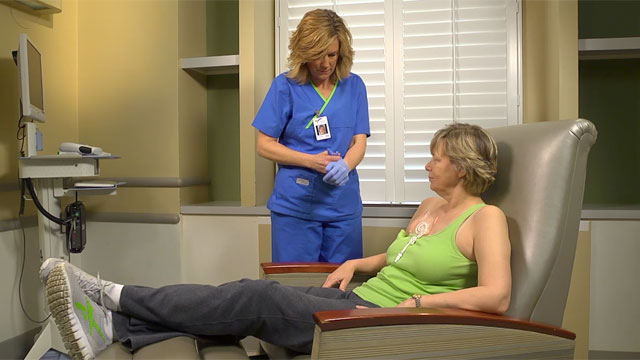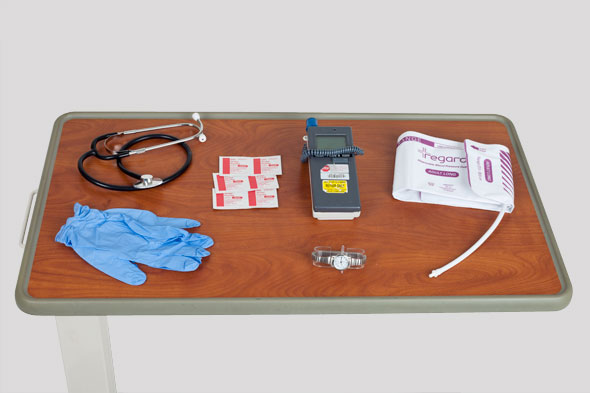Vascular Access
Select a Skill:
- » Performing Dressing Care for a Central Venous Access Device (CVAD)
- » Drawing Blood and Administering Fluid
- » Troubleshooting Vascular Access Devices
Take the Review Test:

Safety
- Observe the Six Rights of Medication Administration.
- Monitor the infusion for patency every 1 to 2 hours, or according to agency policy.
- Check the infusion rate carefully to avoid infusing too rapidly or too slowly.
- Provide dressing changes and flushes according to protocol to maintain the integrity of the CVAD.
- Wear gloves to reduce the risk of contact with infectious microorganisms.
Equipment
(Roll cursor over items to see labels)

Thermometer
Stethoscope
Alcohol swabs
Blood pressure cuff
Watch with second hand
Clean gloves
Delegation
The skill of troubleshooting vascular access devices may not be delegated to nursing assistive personnel (NAP). Delegation of related skills is specified by each state’s Nurse Practice Act. Before delegating related skills, be sure to inform NAP of the following:
- Instruct NAP to inform you if any of the following occurs:
- Vital signs change
- Dressing becomes wet
- Volume of solution in IV bag is low
- Infusion pump alarm sounds
- Instruct NAP to inform you if the patient reports any of the following:
- Cardiopulmonary problems
- Pain, swelling, tenderness, or numbness near the CVAD insertion site
- Nausea or vomiting
Preparation
- Be alert for the following:
- Shortness of breath
- Pain in the chest or shoulder
- Bleeding or swelling at the insertion site or in the neck
- Clot formation in the catheter
- Air embolism
- Infiltration/extravasation during infusions
- Catheter migration
- Erythema, warmth, tenderness, edema, or drainage at the insertion site
- Monitor intake and output, electrolyte values, other laboratory values, and vital signs.
- Ensure continued occlusiveness of the dressing.
- Observe the catheter and its connection points, being sure they are secure and free of leaks, tears, kinks, obstructions, and cracks.
Follow-up
- Continue to observe the patient at least every 1 to 2 hours:
- Check for patency of the CVAD.
- Assess the insertion site, chest, neck, and extremity for pain, swelling, and other changes.
- Assess the patient’s mental status and vital signs.
- Monitor the patient’s intake and output and fluid and electrolyte balance.
- Have the patient describe symptoms of CVAD complications and explain what to do if any develop.
- Change the dressing and IV tubing as often as required by your agency’s policy.
- Report any complications—and your interventions—to the health care provider.
Documentation
- Record your assessment findings.
- Document your interventions related to CVAD complications.
- Record the patient’s response to your interventions and routine care.
- Record your notification of the health care provider about any complications and corrective actions.
Review Questions
1. How would the nurse assess a patient’s central venous access device (CVAD) for damage or breakage?
 Assess the patient’s neck veins for distention.
Assess the patient’s neck veins for distention. Palpate the patient’s arm.
Palpate the patient’s arm. Check the catheter for pinholes and tears.
Check the catheter for pinholes and tears. Palpate the area around the insertion site.
Palpate the area around the insertion site.
2. The nurse is concerned that a patient’s central venous access device (CVAD) may have become dislodged. How might the nurse assess for this complication?
 Check for blood return.
Check for blood return. Palpate the skin for coiling.
Palpate the skin for coiling. Listen for gurgling sounds.
Listen for gurgling sounds. Assess for pain at the site.
Assess for pain at the site.
3. When caring for a patient who has a CVAD, which sign may indicate infection at the insertion site?
 Occlusion alarm sounds on infusion pump
Occlusion alarm sounds on infusion pump Patient’s oral temperature gradually increases
Patient’s oral temperature gradually increases Patient’s neck veins become distended
Patient’s neck veins become distended The nurse cannot achieve blood return
The nurse cannot achieve blood return
4. Which instruction might the nurse give to nursing assistive personnel (NAP) regarding the care of a patient with a CVAD?
 “Assess the site frequently for signs of inflammation.”
“Assess the site frequently for signs of inflammation.” “Be sure to change the transparent dressing on the site once every 7 days.”
“Be sure to change the transparent dressing on the site once every 7 days.” “Let me know immediately if the patient’s dressing becomes damp.”
“Let me know immediately if the patient’s dressing becomes damp.” “Make sure the patient knows to notify me if the site is painful or swollen.”
“Make sure the patient knows to notify me if the site is painful or swollen.”
5. While palpating the skin around a patient’s CVAD insertion site, the nurse elicits a crackling sound. What might this finding indicate?
You have completed the Review Questions for this skill. To take the Review again select the Start Over button. To proceed to another skill select from the dropdown menu. Select the Home or Back button to proceed to the next section.

